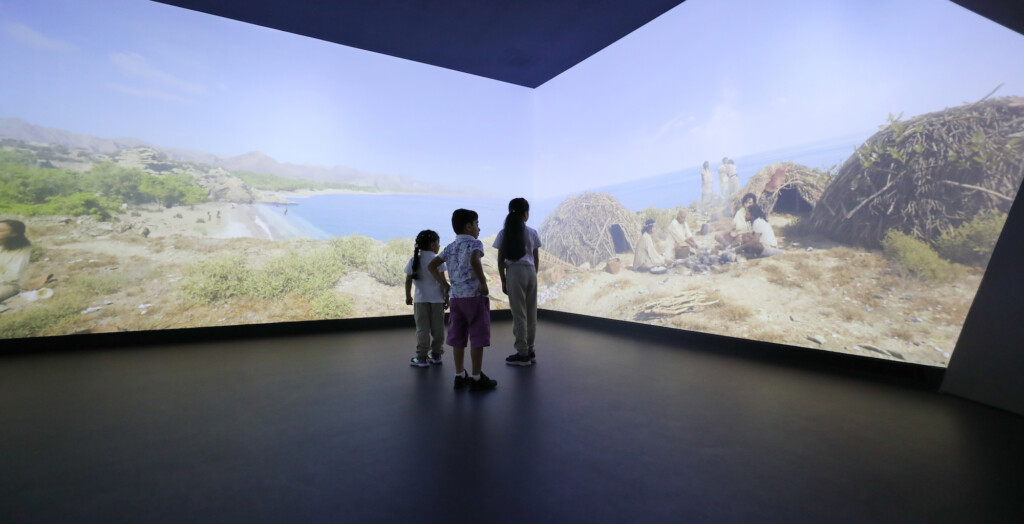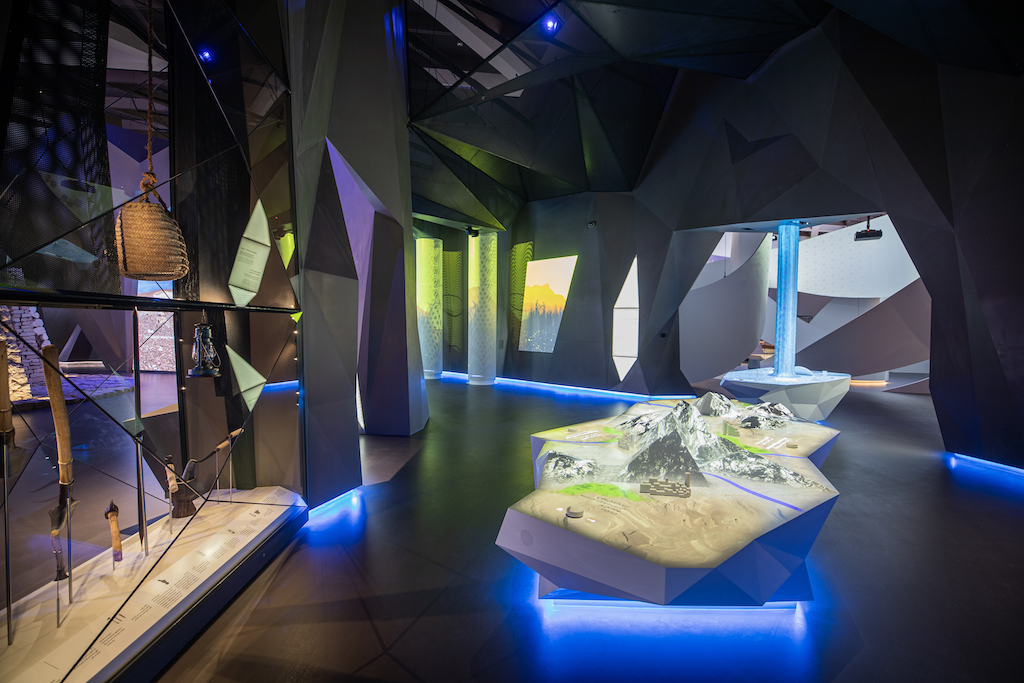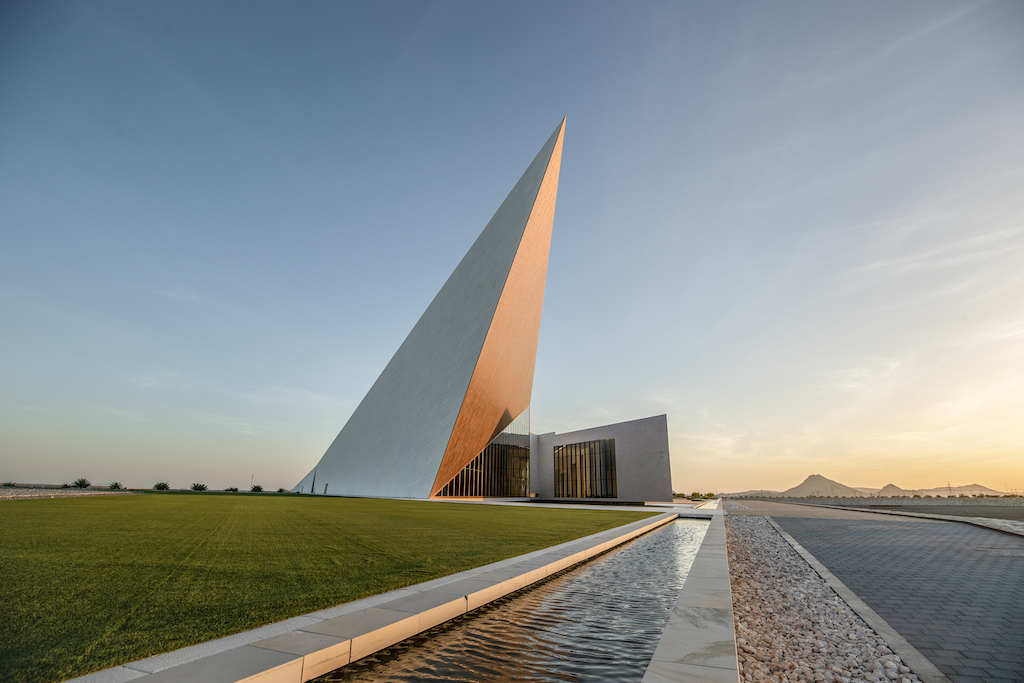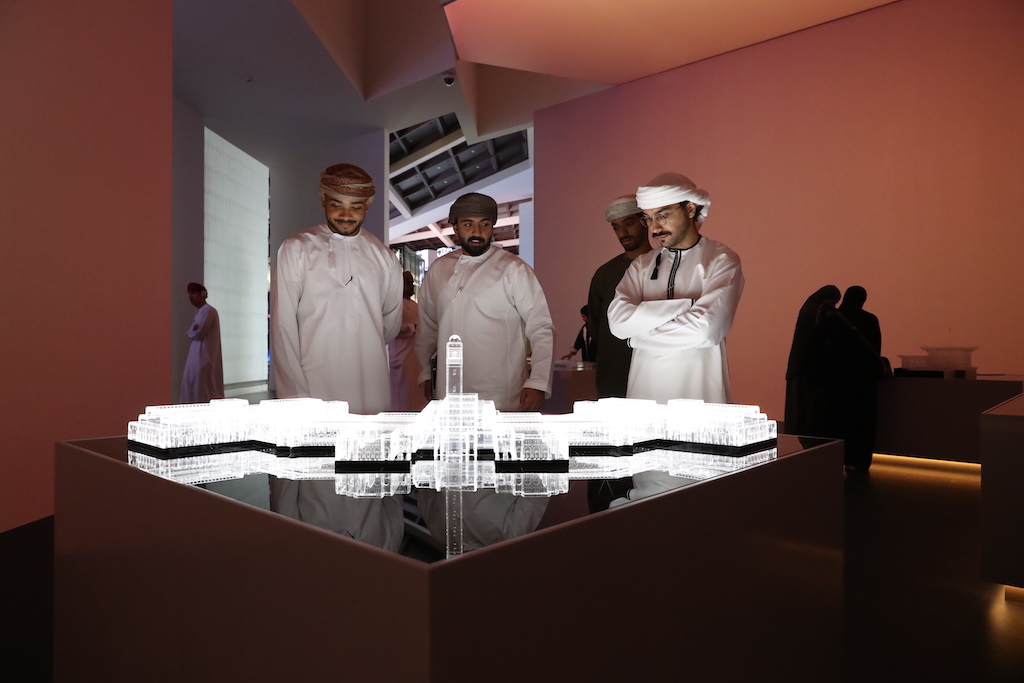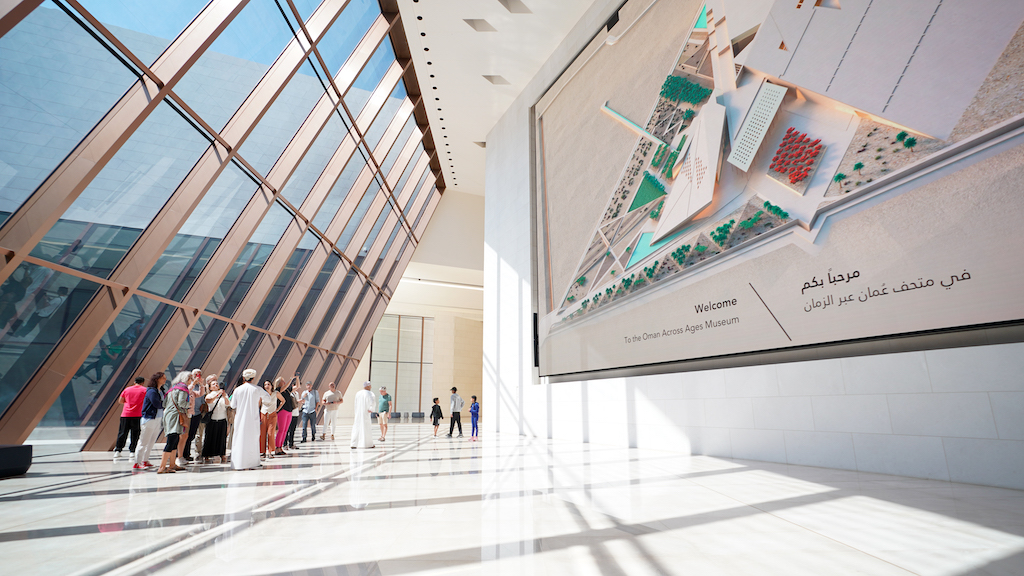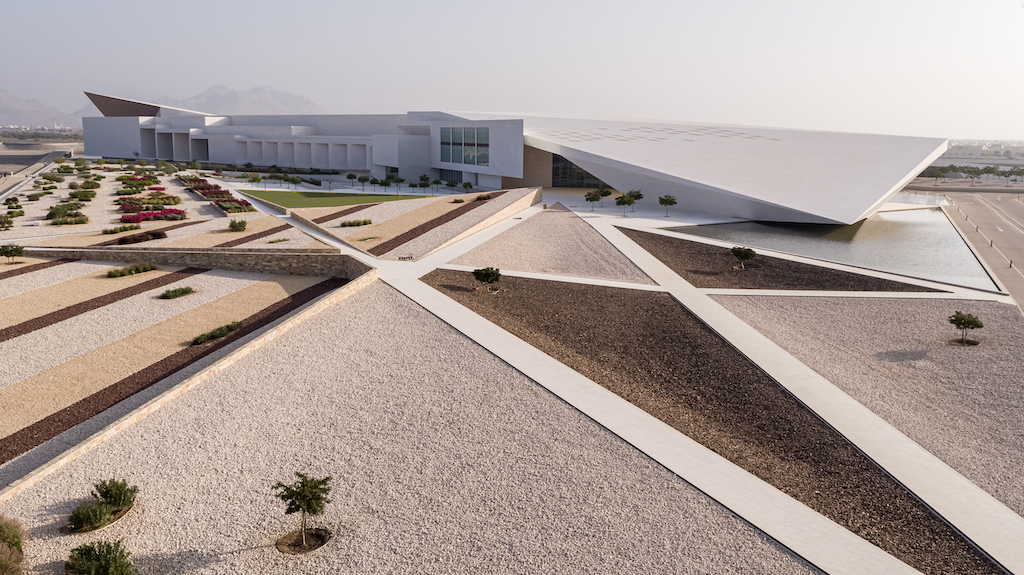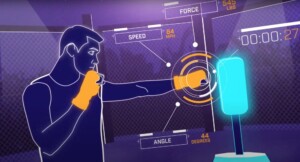The new Oman Across Ages Museum charts the story of the Sultanate of Oman from its geographic pre-history through its evolution to the Renaissance of the 1970s, to the present day and into the future. The museum is home to an auditorium, permanent and temporary exhibition galleries, a vast garden and numerous dining venues, as well as a comprehensive library, the Knowledge Centre.
Eng. Al Yaqdhan bin Abdullah Al Harthi is the director general of the Oman Across Ages Museum. He told blooloop:
“We’re very proud that it is one of the strongest statement pieces of architecture in the Middle East.”
The museum takes inspiration from the landscape and canyons of the Al Hajar Mountains and features on the Architectural Digest (AD) 100 2024 WOW Middle East list of top talents in architectural design as one of the 10 best new buildings in the Middle East. Leveraging scale, form, light, and vistas, the design both harmonises with the landscape and celebrates Oman’s rich heritage.
Inside, open, column-free spaces afford an unobstructed visitor experience. The content traces Oman’s story from its first prehistoric settlers through the following civilisations to its modern renaissance.
Coming up with a storyline
Al Harthi, a civil engineer, has worked on government projects for the last 15 years. The most recent of these is the Oman Across Ages Museum. He had involvement in all aspects of its creation, overseeing the collection, storyline, conservation work, structure, and policies.
“I was handling this from the museum’s initial concept. The museum was built by the vision of the late Sultan Qaboos bin Said al Said, which was to build a museum in Manah, a small village near Nizwa, the ancient capital of Oman. Oman Across Ages is an audiovisual museum, looking at Oman’s history from its geographic and geological origins through to 1970, and then the 50-year renaissance period of achievement that followed under the reign of the late Sultan Qaboos, and into the future.”
Working to this brief, Al Harthi says:
“I started working with the main and the scientific committees to establish the museum’s storyline. We got to a point when we needed a specialised consultant to build the master plan. We then issued the RFP, and the chosen consultant was Event from the UK.”
Event, the experience design agency, began working with the museum team in 2014.
“We started the journey together, brainstorming, meeting the stakeholders, studying the collections, studying the history as well as the operational part, the policies, and such elements as the traffic and the people in the area.
“As part of that scope of work, we developed the architectural brief for an international design competition. We shortlisted 28 architects with previous experience in building new museums. Then we selected the top seven and invited them to Oman to visit the site. We held a Q&A session, and, by the end of the process, had received six proposals.”
In the end, the design chosen, inspired by the mountains of Oman, was by Cox Architects from Perth, Australia.
Exploring a rich history at Oman Across Ages
Oman’s history spans millennia, and the collection reflects this.
“We begin with Oman’s geological and natural history. One highlight is the jawbone of a large primitive elephant species, found in the southern region of Dhofar, and that lived in the region around 350 million years ago, named Omanitherium dhofarensis. Then there is a block of granite that is 800 million years old. We have a lot of fossils, including trilobites from the Wilayat of Mahut.
“We then move into the Stone Age and explore the settlements in Oman. Here, we look at hunting tools and jewellery that have been found.”
The museum’s History Hall and Renaissance Hall comprise a narrative that takes visitors from Oman’s geological origins through the experiences of the early settlers, the successive epochs of Magan civilisation, to the social, economic, industrial and political transformation of the region’s renaissance, and beyond.
Guests can explore the Bronze Age through the Civilisation of Magan pavilion and the Iron Age through the Kingdom of Oman pavilion:
“In the Bronze Age, Oman was the centre of trade between Iraq, Basra, and India. We received wares from India by boat and traded with Basra. We have tablets showing this trade on loan from the British Museum, the Smithsonian, and the Bahrain National Museum. On their route to Basra, the boats stopped in Bahrain, and evidence of this remains.
“We also have some of the Royal Collection, incidentally, to which the people of Oman have a very strong emotional connection. Sultan Haitham had a strong vision for this museum; he worked closely with the project team from the beginning.”
Interactive technology
Oman Across Ages is, predominantly, an audiovisual museum. In addition to its wealth of historical artefacts, it features video exhibits, interactive screens and educational games for children. There is also a Knowledge Centre and interactive Innovation Labs.
In terms of technology, the museum worked with Squint/Opera, the creative studio, throughout the process. “Our focus is on interactive technology,” Al Harthi explains. “They produced more than 50 media installations.”
These span ultra-large format film and animation, as well as interactive content including gesture-triggered experiences, and VR. He adds:
“We also have interactive projection mapping, many interactive screens, and pillars which are huge columns of LED screens presenting one movie. It’s an incredibly immersive experience. We have huge databases for everyone from academic researchers to school students, with interactives.
“The whole museum and all its content is fully accessible.”
In many cases, the museum has 3D-printed replicas of items from the collection as a tactile collection so people can handle and explore them. As well as interpretive handling collections, there is Braille, electronic audio devices, wheelchairs and golf carts for transportation.
Diving into the data, he says:
“We have 310 films, 1200 interactive screens, 2D, 3D and projection mapping, a collection comprising 1300 objects, 80 replicas, 61 km of fibre optic cables, 21 km of audio-visual cables, and 150 showcases.”
Large-scale exhibits at Oman Across Ages
Often, Al Harthi contends, it is the sheer scale of the displays that differentiates the museum’s space:
“We have an art piece, for instance, that is a reconstruction of a Magan ship. This is made of reed bundles painted with tar, with ropes of palm fibres and woollen sails, and is ten metres high.”
Elsewhere, the museum has used 3D scanning and printing on a massive scale to reimagine the geological structure of a folded rock:
“Everything is huge,” he comments. “The exhibition is, essentially, one open space. It is divided into many pavilions, but as an architectural piece, it’s one 10,000 square metre space.”
In terms of the audience, he adds:
“It’s aimed at everybody. Our main target is young people. Their language is technology, so we have given them the history of our country through AV and interactive technology. We have had more than 350,000 visitors within nine months. This is an amazing number when you consider our business plan talked about reaching 200,000 in a year. Our peak was 11,800 visitors in one day.”
A full-day experience
The museum also has a strong educational programme, and is coordinating its educational strategy daily:
“Omani and international schools make up one of our core audiences. We have around 160 student visits daily,” he explains. “We hold special tours and workshops for them.”
General visitors tend to spend a full day at the museum:
“The guided tours last for two hours. But we see a museum visit as a full-day experience, and this is how the facilities have been designed. The museum is a large building, and the ticket is only needed for the exhibitions. Otherwise, people are free to move around and to use the facilities as they please – the cafés, restaurants, retail, toilets, the prayer room – before coming back into the exhibition spaces.”
Additionally, he says:
“The guided tour offers general information about the museum. If you want to dive into more granular detail, it will require more time. We have one of the largest libraries in Oman – our Knowledge Centre. So, if researchers have more queries or are looking for references on the information inside the museum, they can go to the library. Here, they can get all the information, books and references that they need, and go through them.
“Most of our collection, including manuscripts and photos, is available in our Knowledge Centre in digital form, so they can explore it there, too.”
Chronological and thematic displays at Oman Across Ages
The History Gallery is interpreted chronologically, but the Renaissance Gallery takes a thematic approach.
“It was part of the masterplan, to have a mix of chronological and thematic interpretation,” Al Harthi explains. “We also have a 1,200-square-metre multi-purpose hall with the latest technology.”
The hall, which can hold around 600 people, can host lectures, conferences or workshops. It covers a total area of 1,200 sqm:
“We are using it this year because our programme is so busy, both with conferences organised by the museum, and events organised by other institutions.”
The hall will, in the future, also host the museum’s temporary exhibition programme.
There is also the 319-seat auditorium overlooking terraced gardens containing frankincense trees and date palms, and the innovation, creation and computer labs, where weekly workshops are run for a range of different groups in the community.
Al Harthi comments:
“It’s part of our strategy to have a loyalty programme. We want to encourage everybody to feel a sense of ownership: that it is their museum. One great thing we have seen is that when we target students, they return to their parents and siblings, encouraging them to visit the museum.
“In addition to that, the museum is so huge and so rich in content that after a couple of hours, people can feel tired. So, they leave – but they come back. We have many repeat visits.”
A Future Museum
Concerning technology, CNN categorises Oman Across Ages as one of five Future Museums in the world. This is of significant benefit to the region, enriching the area as well as adding to the cultural scene, says Al Harthi.
“The project helps in decentralising tourism. It aims to support the development of big projects in the interiors of Oman that have enormous tourism potential. Manah is the ideal location for the museum. It brings tourists to more interior areas of Oman, giving them an authentic feel and understanding of the Omani heritage.”
“To have such building and such technology in the interior of Oman creates the potential for a future city to be developed and built within the surrounding area of the museum.”
The vision of the Oman Across Ages Museum is to be a world-class visitor destination that strengthens the relationship of Omani youth with their cultural heritage, transforming the way they engage with their country and also inspiring them to participate in shaping its future:
“The museum’s mission is to promote an appreciation and understanding of Oman’s unique characters, history and renaissance to national and international audiences.”
Sustainability at Oman Across Ages
Returning to the building, he explains:
“One of the main considerations was to ensure the visitors’ experience would be all on one floor, so they wouldn’t be constantly travelling up and down between levels. This helps in the flow of the journey. It also helps with accessibility and in the event of any emergency that might arise.
“The building is designed as a LEED silver-level sustainable building. Though we didn’t apply for the certification at the outset, we are doing so now.”
Conceived as an environmentally friendly structure, the building’s eastern side has a low profile. In the morning, the interior is protected from direct sunlight. On its western side, windows set in slanted walls minimise the sunlight’s direct impact, while reducing the need for lighting. In a concept that echoes the building techniques of ancient castles, the stone walls cool the surrounding hot air.
Concerning sustainability in use, the architects also reduced the operational energy requirements by exploiting thermal mass to minimise cooling needs. The design includes an underground mechanical system that ensures efficient temperature control by drawing air in through a labyrinth.
He adds:
“Three materials are used for the façade: stone, brass, and glass. If you look at the building from any angle, you see only these three materials. This goes back to the geological and geographic vision behind the museum. The stone is an Omani stone from the mountains.”
Celebrating knowledge
The walls of the museum, inside and out, are clad with 130,000 square metres of Omani stone from the governorates of A’Dhahirah and North Al Batinah. Leftover stones have been used in the museum’s garden:
“The brass reflects the history of Oman and the Magan civilisation. Oman was the centre of trade in the Bronze Age.”
In terms of the structure:
“The building starts in the south at ground level, with the Knowledge Centre, and then grows towards the History Gallery, and its peak in the north, over the Renaissance Gallery, shows a line of continuing growth that goes on and on. Any achievement of humanity needs to start with knowledge. This is the architect’s philosophy.”
